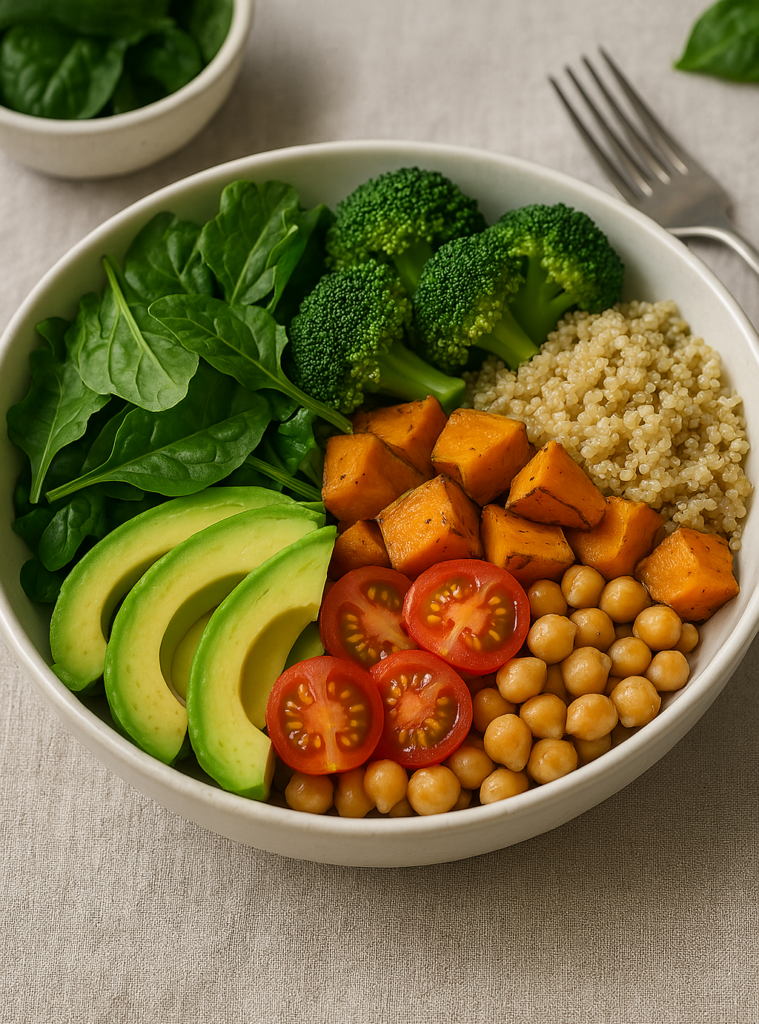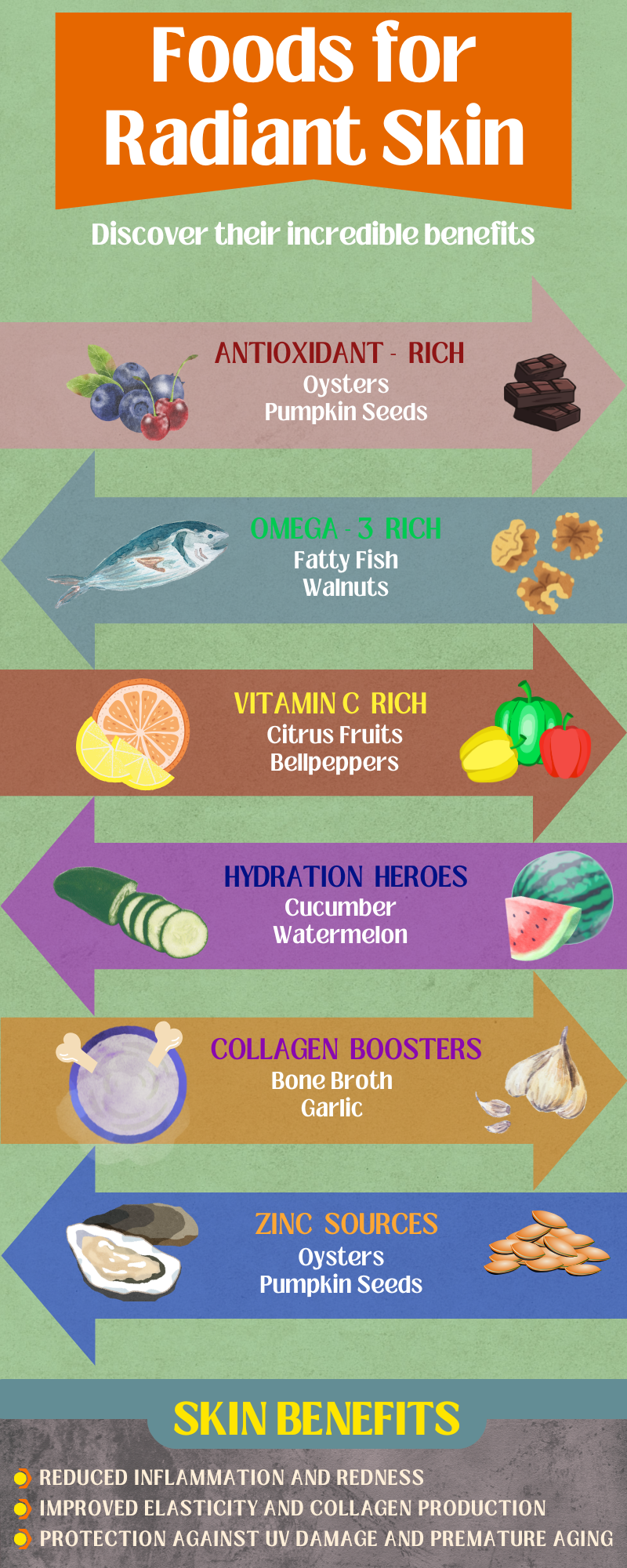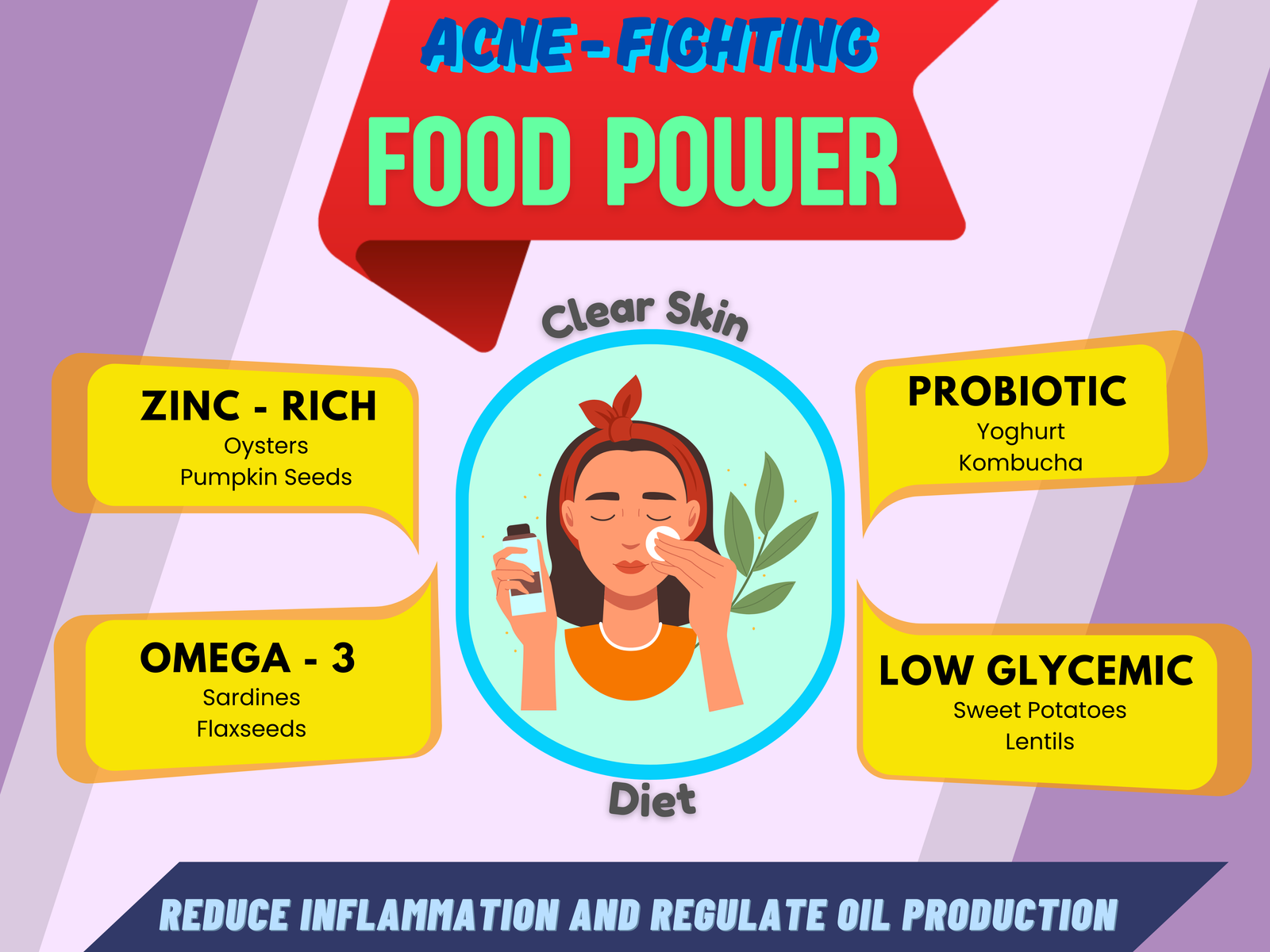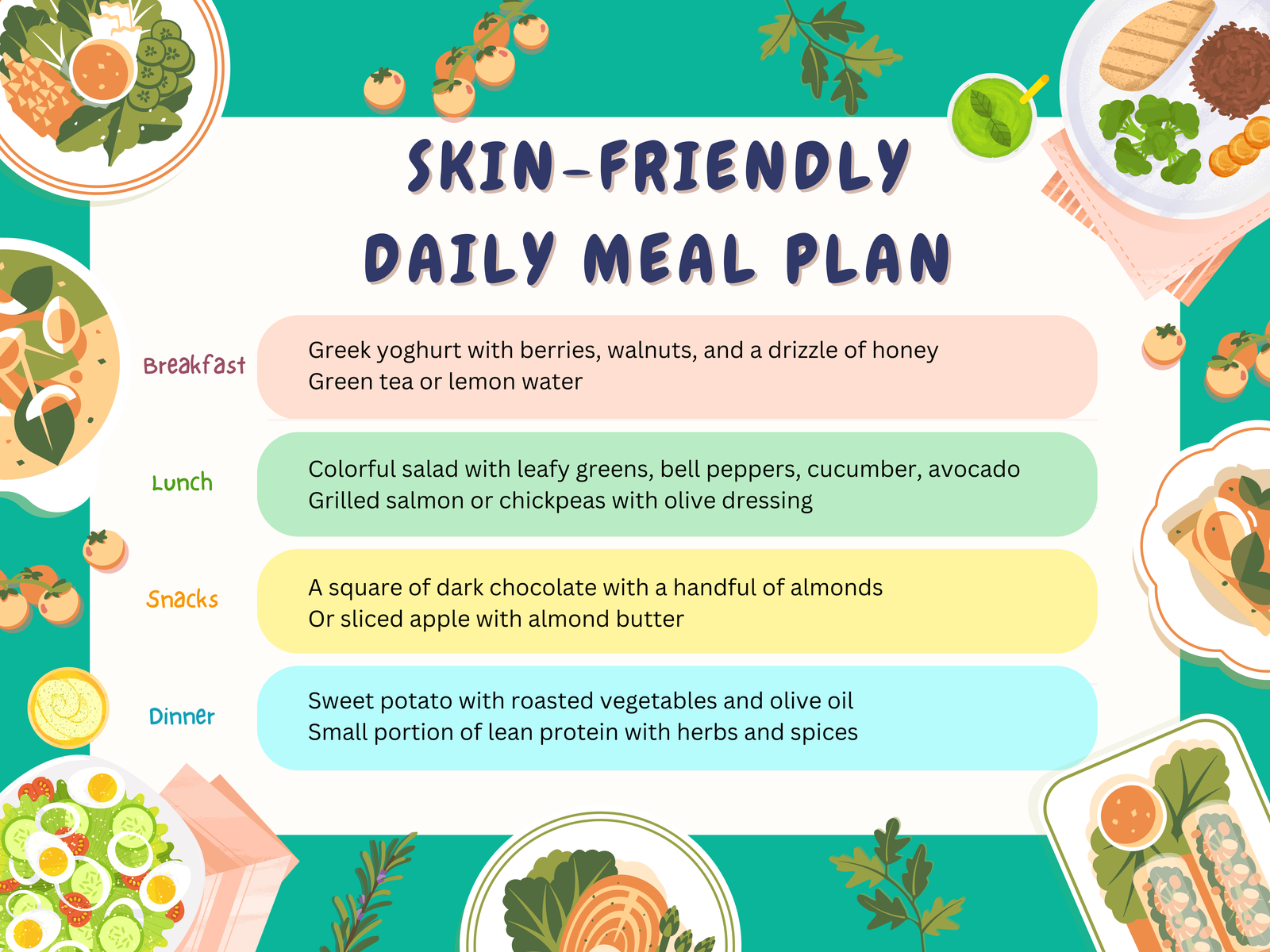A Food Guide for Your Face

Are you slathering on expensive serums while ignoring what’s on your plate? Plot twist: your kitchen might be holding the secret ingredients to that dream skin you’ve been chasing! Let’s dive into the world where nutrition meets skincare – no complicated jargon, just straight-up food facts that’ll have your skin thanking you.
The Skin-Food Connection: More Than Just Surface Deep
Ever noticed how your skin throws a mini tantrum after a weekend of pizza and ice cream? That’s no coincidence, my friend. Our skin is basically a chatty organ that loves to gossip about what we’ve been eating.
Your skin is your largest organ (yes, it beats out all the others in the size department), and it’s constantly regenerating. This means it needs a steady supply of nutrients to look its perky best. Think of good food as your skin’s best buddy – always there to support and nourish.

Antioxidant All-Stars: Your Skin’s Defense Team
If your skin were playing a superhero movie, antioxidants would be the Avengers – assembled to fight off the bad guys (free radicals) that cause premature aging and damage.
Berries: Nature’s Candy with Benefits
Blueberries, strawberries, blackberries – basically any berry that can potentially stain your favorite shirt is packed with skin-loving nutrients. These colorful gems are loaded with antioxidants that combat free radical damage (that’s science-speak for “they help prevent wrinkles”).
Fun fact: A cup of strawberries has more vitamin C than an orange! This vitamin is crucial for collagen production – the protein that keeps your skin bouncy and youthful. Next time you’re grocery shopping, throw in an extra pack of berries. Your future self (and skin) will be eternally grateful.
Dark Chocolate: The Dessert Your Skin Actually Wants
Yes, you read that right! Dark chocolate (the kind with at least 70% cocoa) is rich in flavanols that protect against sun damage. Not saying you should ditch sunscreen, but a square of dark chocolate might be your skin’s new BFF.
Pro tip: Pair it with some almonds for a skin-nourishing snack that also satisfies those 3 PM cravings.
Omega-3 Rich Foods: The Moisture Magnets
Dry, flaky skin? Before you invest in yet another moisturizer, check your omega-3 intake.
Fatty Fish: The Underwater Skin Saviors
Salmon, mackerel, and sardines are swimming in omega-3 fatty acids, which strengthen cell membranes, lock in moisture, and reduce inflammation. Think of omega-3s as your skin’s internal moisturizer.
Kitchen hack: Not a fan of fish? Try salmon cakes! Mix canned salmon with an egg, breadcrumbs, and spices, then pan-fry. Even fish skeptics might be converted.
Walnuts and Flaxseeds: Plant Power for Your Pores
If you’re plant-based or just not into fish, walnuts and flaxseeds are excellent sources of omega-3s. They also contain zinc, which is like a drill sergeant for your skin cells – keeping everything in order and helping with healing and regeneration.

Vitamin C Champions: Collagen’s Best Friends
Vitamin C isn’t just for fighting off colds – it’s essential for collagen production, the scaffolding that keeps your skin firm and plump.
Foods rich in vitamin C, like citrus fruits and bell peppers, can brighten skin and reduce pigmentation, including under-eye circles. If you struggle with dark circles, check out our detailed guide on causes and remedies: Dark Circles: A Thing of the Past
Citrus Fruits: Zesty Skin Boosters
Oranges, lemons, grapefruits – these tangy delights are packed with vitamin C. They also have a low glycemic index, which means they don’t cause the insulin spikes that can trigger acne and inflammation.
Breakfast upgrade: Squeeze half a lemon into warm water first thing in the morning. It’s like sending your skin cells a “wake up and glow” text.
Bell Peppers: The Colorful Complexion Enhancers
Red bell peppers contain more vitamin C than oranges – surprising, right? They’re also loaded with carotenoids that can help protect skin from sun damage and environmental pollutants.
Quick idea: Slice them up and dip in hummus for a skin-nourishing snack that’s crunchy and satisfying.
Hydration Heroes: Water-Rich Wonders
Hydrated skin is happy skin. These foods have high water content to keep your cells plump and your complexion dewy.
Cucumber: The Spa Day Standard
There’s a reason cucumbers are the poster child for skincare. They’re 96% water and contain silica, which helps strengthen connective tissue. They also have a cooling effect that helps reduce puffiness – especially useful after a late night or crying session watching tear-jerkers.
DIY spa moment: Keep cucumber slices in the fridge for a quick de-puffing eye treatment. Your tired eyes will thank you.
Watermelon: Summer’s Skin Savior
This juicy treat is 92% water and rich in lycopene, an antioxidant that helps protect skin cells from damage. It’s basically hydration with a side of skin protection.
Summer snack hack: Freeze small watermelon chunks for a refreshing treat that doubles as skin food.
Anti-Aging Arsenal: Foods That Turn Back the Clock
While we can’t stop time (yet), certain foods can help slow down the visible signs of aging.
Avocados: The Good Fat Glow-Givers
Avocados are packed with healthy fats that help maintain skin elasticity and moisture. They’re also rich in vitamin E, which helps protect against oxidative damage. Next time someone side-eyes your avocado toast addiction, tell them it’s for your skin!
Try this: Mash avocado with a bit of honey for a quick, natural face mask. Leave on for 15 minutes, then rinse. Hello, instant glow!
Green Tea: The Ancient Anti-Ager
Green tea is loaded with catechins, powerful antioxidants that fight inflammation and protect against skin cancer. It also contains L-theanine, which helps reduce stress – and we all know stress isn’t exactly a friend to good skin.
Daily ritual idea: Swap one of your daily coffee cups for green tea. Your jittery nerves and your skin will thank you.
Acne-Fighting Foods: Combat Breakouts from Within
If you’re battling breakouts, your diet could be a secret weapon in your skincare arsenal.
Probiotic-Rich Foods: Gut Health = Skin Health
Yogurt, kefir, and kombucha are packed with good bacteria that help balance your gut microbiome. This might seem unrelated to your skin, but research shows that gut health and skin health are closely connected.
Morning routine upgrade: Top your plain yogurt with some berries and walnuts for a triple-threat skin food breakfast.
Zinc-Rich Foods: The Acne Adversaries
Oysters, pumpkin seeds, and chickpeas are loaded with zinc, which helps regulate oil production and reduce inflammation. It’s like having a built-in oil control system for your face.

Foods to Limit: The Skin Saboteurs
Before you panic, this isn’t about eliminating joy from your life. It’s just about being aware of how certain foods might be affecting your skin.
Sugar: The Sweet Saboteur
Excessive sugar consumption can lead to glycation, a process that damages collagen and elastin – the proteins that keep your skin firm and elastic. This doesn’t mean you can never enjoy dessert again; just be mindful of how much and how often.
Dairy: The Complexion Conundrum
For some people (not everyone!), dairy can trigger acne flare-ups. If you’re consistently dealing with breakouts, you might want to experiment with reducing dairy for a few weeks to see if there’s any improvement.
Alternative idea: Try nut milk in your coffee or cereal. Almond milk makes a particularly creamy substitute!
Putting It All Together: Your Skin-Friendly Meal Plan
Creating a skin-nourishing diet doesn’t have to be complicated. Here’s a simple framework:
- Build your plate with colorful veggies and fruits – aim for at least 5 different colors daily
- Include a source of healthy fats with each meal (avocados, nuts, seeds, olive oil)
- Stay hydrated – water is your skin’s best friend!
- Limit sugar and processed foods – think of them as occasional treats rather than daily staples
- Listen to your skin – if certain foods seem to trigger breakouts, take note and adjust accordingly
Bonus: Skin-Supporting Superfood Combos
There’s something magical about certain food combinations that can amplify their skin benefits. Think of these as power couples for your complexion:
Turmeric + Black Pepper: The Dynamic Duo
Turmeric contains curcumin, a powerful anti-inflammatory compound that can help calm irritated skin and reduce redness. But here’s the catch – your body doesn’t absorb curcumin very well on its own. Adding a pinch of black pepper increases absorption by up to 2000%!
Try this: Add a sprinkle of turmeric and black pepper to your morning scrambled eggs or smoothie. You won’t taste much, but your skin will reap the benefits.
Vitamin C + Iron: The Absorption Enhancers
Iron is crucial for carrying oxygen to skin cells, but plant-based iron can be hard for your body to absorb. Enter vitamin C, which can boost iron absorption significantly.
Power plate idea: Spinach salad (iron) with sliced strawberries (vitamin C) and a lemon vinaigrette for maximum absorption.
The Skin-Gut Connection: Your Internal Ecosystem
Recent research has shown that your gut health and skin health are more closely connected than we previously thought. This connection is often called the “gut-skin axis.”
Prebiotic Foods: Feeding Your Good Bacteria
While probiotics introduce good bacteria to your gut, prebiotics are the food that helps those bacteria thrive. Think of them as fertilizer for your gut garden. Foods rich in prebiotics include:
- Garlic and onions
- Bananas (slightly underripe)
- Jerusalem artichokes
- Asparagus
- Oats
- Apples
Simple addition: Add a clove of garlic to your cooking whenever possible – it’s practically undetectable in most dishes but packs a prebiotic punch.
Fermented Foods: More Than Just Trendy
Kimchi, sauerkraut, miso, and other fermented foods don’t just make for interesting restaurant menus – they’re packed with probiotics that support gut health, which in turn supports skin health.
Start small: If you’re new to fermented foods, begin with small amounts to allow your system to adjust. Even a tablespoon of sauerkraut with your meal can be beneficial.
Seasonal Skin Support: Adapting Your Diet Year-Round
Just as your skincare routine might change with the seasons, your skin-supporting diet can benefit from seasonal adjustments too.
Summer Skin Foods: Protection from Within
In the warmer months, focus on:
- Watermelon and cucumber for hydration
- Tomatoes for lycopene (natural sun protection)
- Leafy greens for antioxidants
- Citrus fruits for vitamin C to counter sun damage
Winter Skin Foods: Combat Dryness
When the temperature drops:
- Increase healthy fats (avocados, nuts, seeds, olive oil)
- Bone broth for collagen support
- Sweet potatoes for vitamin A to help cell turnover
- Extra water (we often forget to hydrate in colder weather)
Budget-Friendly Skin Foods: Glow Without Breaking the Bank
Good skin nutrition doesn’t have to be expensive! Here are some wallet-friendly options that pack a serious skin-supporting punch:
- Oats: Rich in zinc, antioxidants, and fiber for balanced blood sugar
- Carrots: Loaded with beta-carotene for vitamin A production
- Canned sardines: A budget-friendly source of omega-3s
- Frozen berries: Often cheaper than fresh but just as nutritious
- Sunflower seeds: Full of vitamin E for skin repair
- Beans and lentils: Protein and zinc without the high price tag
Money-saving tip: Buy produce that’s in season and freeze extra portions for smoothies or cooking later.
Creating Your Personal Skin-Food Journal
Everyone’s skin is unique, and what works wonders for one person might not have the same effect on another. Consider keeping a simple food-and-skin journal for a few weeks to identify your personal triggers and boosters.
- Note what you eat each day
- Track how your skin looks and feels
- Look for patterns over time
- Gradually increase skin-supporting foods
- Slowly reduce potential trigger foods
This isn’t about restrictive dieting – it’s about becoming aware of how your food choices may be influencing your skin and making informed adjustments.
The Bottom Line:
For a Radiant Glow from Within, Consistency is Key.
What’s your experience with food affecting your skin?
Have you noticed any particular foods that make your skin better or worse?
Share in the comments below!
Looking for quality skincare products to complement your healthy diet?
Stay tuned for our upcoming product recommendations that work hand-in-hand with these nutrition strategies!



